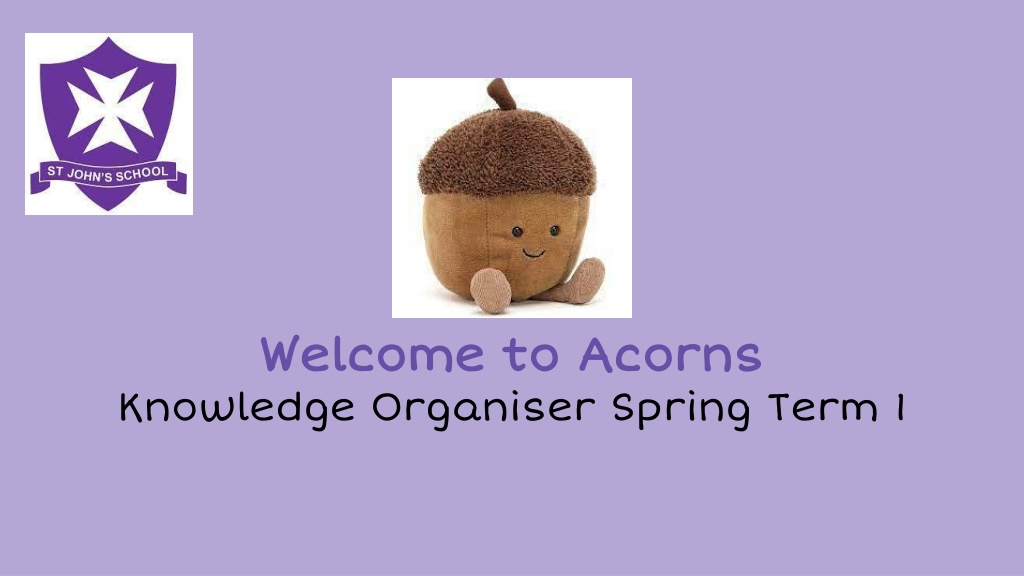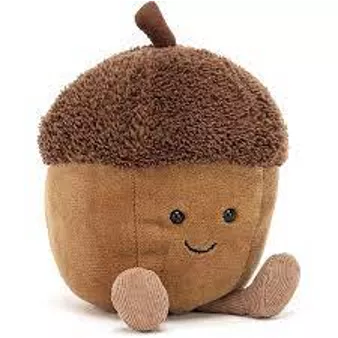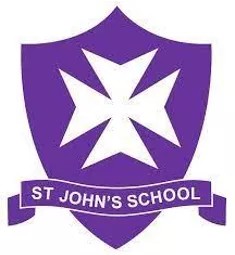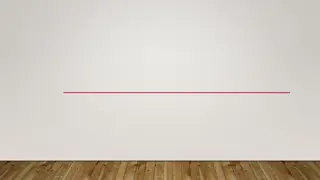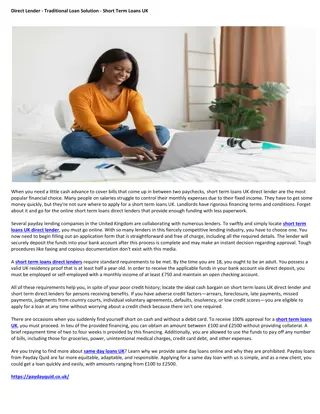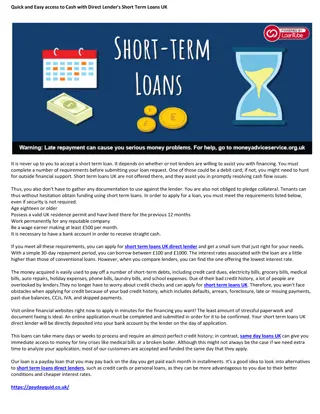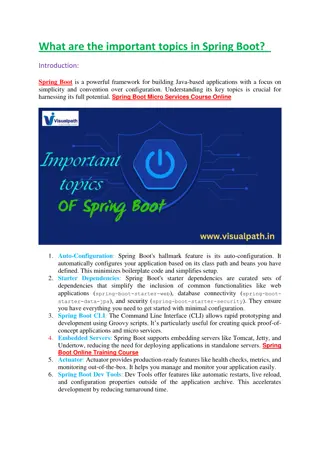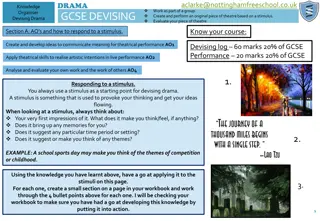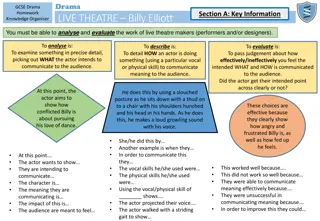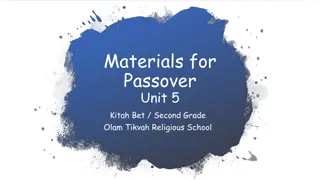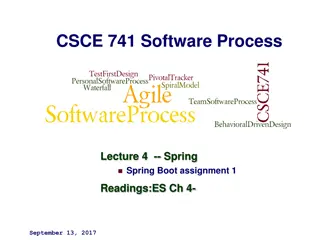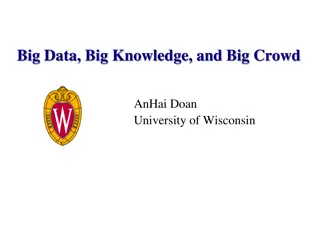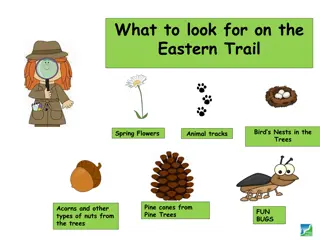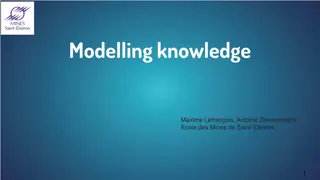Spring Term 1: Acorns Knowledge Organiser
Acorns Spring Term 1 focuses on Communication and Language, Personal, Social & Emotional Development, Physical Development, and Cognitive Skills. The curriculum encourages listening skills, storytelling, expressive language, emotional awareness, physical activities, and cognitive development through various engaging activities. Home learning tasks involve retelling stories, practicing new skills, and enhancing motor skills. It aims at holistic growth and learning experiences for young children.
Download Presentation

Please find below an Image/Link to download the presentation.
The content on the website is provided AS IS for your information and personal use only. It may not be sold, licensed, or shared on other websites without obtaining consent from the author. Download presentation by click this link. If you encounter any issues during the download, it is possible that the publisher has removed the file from their server.
E N D
Presentation Transcript
Welcome to Acorns Welcome to Acorns Knowledge Organiser Spring Term 1
Communication and Language Communication and Language Listening: Listening: Listen carefully to rhymes and songs, paying attention to how they sound. Attention: Attention: Make up our own stories - Introduce Story Scribing/ Helicopter Stories. Vocabulary Concepts: Respond: Respond: Join in with repeated phrases of traditional tales. Express their ideas and feelings about their experiences using full sentences, including use of past, present and future tenses and making use of conjunctions, with modelling and support from their teacher s and songs, paying attention to how they sound. First, next, beginning, middle, end, after, then, next, character, plot, setting, story, book, where, why, when, what. Understanding: Understanding: Share our favourite stories from home. Talk through main events of stories. Revisit/ ongoing throughout the year: Learn new vocabulary Use new vocabulary in different contexts Use new vocabulary through the day in discussions and conversations Learn new rhymes, poems, songs,traditional stories Listen to and talk about stories to build familiarity and understanding Speaking: Speaking: Articulate their ideas and thoughts in well-formed sentences. Use and celebrate newly acquired vocabulary. Participate in small group, class and one-to-one discussions, offering their own ideas. Connect one idea or action to another using a range of connectives. Home Learning: Retell traditional stories in sequence and using repetitive language found in the text eg Run, run as fast as you can.
Personal, Social & Emotional Personal, Social & Emotional Development Development Express feelings: and social skills Express feelings: and social skills Identify and moderate their own feelings socially and emotionally. Talk about how they are feeling and be able to label these emotions. Manage behaviour: / Self Manage behaviour: / Self- -awareness: Compromising and solving conflicts; understanding how actions affect others. Be able to engage in reflective conversations based around conflict or behaviour. awareness: Vocabulary: Challenges, perseverance, jobs, Responsibilities, taking turns, being polite, manners, help, dreams, goals. Show resilience and perseverance in the face of challenge. Revisit/ ongoing throughout the year: Continue to develop skills of using gestures, non-verbal communication, facial expressions, body language, appropriate language, and vocabulary Listen to others, speak to peers and adults and engage in discussions in a positive way Jigsaw: Dreams & Goals Discussion about the Christmas holiday. Challenges Perseverance Goal-setting Overcoming obstacles Seeking help Jobs Achieving goals Home Learning: Decide upon and practise a new skill. Take pictures to bring in and share.
Revisit/ ongoing throughout the year Physical Development Physical Development Continue to develop overall body- strength, balance, coordination, and agility through use of outdoor play equipment. REAL PE FOCUS REAL PE FOCUS Personal Cog Focus: Personal Cog Focus: Cognitive skills; to follow and understand simple Cognitive skills; to follow and understand simple instructions and name some things i am good at. instructions and name some things i am good at. Fundamental movement skills: Fundamental movement skills: dynamic balance dynamic balance- - maintain balance while walking in a line maintain balance while walking in a line static balance static balance- - exploring stance with good control exploring stance with good control Home Learning Use scissors to cut out simple shapes accurately by tracing the line. Use your shapes to make a picture. Gross motor: Gross motor: Ball skills- aiming, dribbling, pushing, patting, or kicking. Develop confidence, competence, precision, and accuracy when engaging in activities that involve a ball. Vocabulary Fine motor: Fine motor: Begin to form letters correctly Dribbling, patting, catching, kicking, aiming, target. Balance, climbing, symmetry. Construct, tools, snip, cut, join, fold. Handle tools, objects, construction and malleable materials with increasing control
Literacy Literacy Vocabulary: Phoneme, sound, phoneme frame, sound buttons, grapheme, rhyme, print, words, letters, sounds, books, story, blend, segment, word, sentence, finger space, full stop, caption, facts, non-fiction, title, label, explain, actions, re-tell, sequence, props, picture, characters, problem, beginning, middle, end, character description, fiction, story map, once upon a time, then, now, emotions, scared, sneaky, naughty. Revisit/ ongoing throughout the year Re-read books to build up their confidence in word reading, their fluency and their understanding and enjoyment. Read books consistent with their phonic knowledge. Writing: Writing: Extend spoken vocabulary. Recognise some familiar words. Begin to form letters correctly. Use writing as a means of communicating to audience Write own name and labels/captions Write simple refrain from the story. E.g. Run, run as fast as you can. Language: Language: Introduce word of the day, display and celebrate the use of new words. Introduce Grandma Fantastic and her vocabulary in her basket. COMPREHENSION: COMPREHENSION: Demonstrate understanding of what has been read to them by retelling stories and narratives using their own words and recently introduced vocabulary. Anticipate (where appropriate) key events in stories. Retell a story with story language and a problem. WORD READING: WORD READING: Begin to segment sounds and blend. Read some letter groups that each represent one sound and say sounds for them. Read a few common exception words matched to Phonic Bug. Handwriting: Handwriting: Pegs to Paper & Penpals. Penpal handwriting books used to practise formation. Home Learning: Helicopter Stories: Helicopter Stories: Adults to scribe children s stories and act them out on a story stage. F Fold paper to make your own book including characters old paper to make your own book including characters from familiar stories. from familiar stories. Can you read the story to your family at bedtime?
Revisit/ ongoing throughout the year The Write Stuff Continue to develop general sound discrimination, rhythm and rhyme, alliteration, voice sounds, oral blending, and segmenting. 1. 2. 3. Understanding of the uniqueness of each child Nurturing deep talk and developing listening Providing a rich repertoire of real and imagined experiences to ignite writing Grandma Fantastic EYFS Rainbow Phonics Phonics Phase 3 phonics - learning digraph phononems and word building with these sounds: Sh, ch, th, ai, ee, oa, oo, oo, igh. Home Learning Can you carry out a sound walk using your phonic cards? What can you find contain the digraph sounds we have learnt this term?
Mathematics Mathematics Vocabulary: Four, five, six, seven, build, count, one more, oneness, recognise Predict, add, take away, equals, sides, shapes, square. Rectangle, corners, number line, order, smallest, biggest, difference, count back, count forwards, number bonds. Number and Patterns: Number and Patterns: Composition of 4, 5, 6, 7 Adding and subtracting to 4 and 5 Digging Deeper / Problem solving: Children solving problems relating to addition and subtraction to 5. Early doubling. Count reliably any arrangement of up to 7 objects Find one more and one less than a number from 1 to 10 Begin to estimate how many objects can be seen and check by counting (up to ten) Shape Space and Shape Space and Measures: Recognise patterns Use everyday language related to capacity Days of the week Measures: Home Learning: Can you use a mirror to double a group of objects?
Understanding the World Understanding the World Revisit/ ongoing throughout the year Communication: Communication: Understand the past through settings, characters and events encountered in books read in class and storytelling Vocabulary: Chinese New Year, Chinese dragon, Chinese numbers, Chinese lantern, past, present, future, change, winter, season, environment, ice, cold, frozen, wind, sun, sky, moon, light, dark, heat. Observation: Observation: Winter Trees RE: RE: What can we learn from stories? Looking at a range of stories with strong morals from different religions. Science Science Recognise some environments that are different to the one in which they live. Lunar New Year & Chinese New Year - how is this celebrated around the world and how do people prepare for the celebration? Snap Science Snap Science- What happens at night? What is in the sky? What is the moon? Forest School: Forest School: Tools saw & loppers Home Learning: Research how Chinese New Year is celebrated around the world. Discovery RE: What can we learn from stories?
Colour mixing secondary colours Rockets 3D collages Construction Dancing/mime to music Expressive Arts and Expressive Arts and Design Design Artist study -Mondrian (primary colours) Performance - Chinese New Year songs Vocabulary Primary colours, secondary colours, Joining, rolling, folding, stencils, decorating, dabbing, sponging, moving, split pins, structure, purpose Perform, sing, dance. Design - design,make and evaluate Chinese New Year decorations Charanga: Everyone Unit: Charanga: Everyone Unit: Wind The Bobbin Up Rock-a-bye Baby Five Little Monkeys Jumping On The Bed Twinkle Twinkle If You're Happy And You Know It Head, Shoulders, Knees And Toes Musical Activities that embed pulse, rhythm and pitch, explore voices and classroom instruments. Copy-clap some rhythms of phrases from the songs. Explore high pitch and low pitch in the context of the songs. Revisit/ ongoing throughout the year Explore, use, and refine a variety of artistic effects to express their ideas and feelings. Return to and build on their previous learning, refining ideas and developing their ability to represent them Explore and engage in music making and dance, performing solo or in groups.
